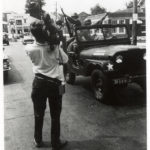Call for Submissions
Cine Tectonica: Film On The Faultline
Alan Wright of the University of Canterbury, New Zealand, has made a call for articles for a book to be titled Cine Tectonica: Film on the Faultline (Intellect Press). Abstracts of 250 words, along with a short biography, are due to him – alan.wright@canterbury.ac.nz – by February 6, 2012.
In his announcement, Wright says:
“The recent earthquakes in Chile, Christchurch, and Japan have left a host of powerful images in the minds and memories of millions of people around the world. Film has always played a crucial role in the imagination of disaster. From its earliest days, cinema has registered the impact of seismic events. The aftermath of the 1906 San Francisco earthquake is recorded on film. In New Zealand, footage from the Napier earthquake of 1931 shows the destruction of the town. Hollywood even recast New Zealand in Green Dolphin Street (Saville, 1947) as the fictional setting for a special effects mega-quake and tsunami.
“An earthquake is also a conceptual event of telluric proportions. An emergent seismic consciousness, reflected in a number of contemporary films from Iran, Chile, Haiti, Japan, Greece, Turkey, Italy, Korea, the USA, and New Zealand, has shaken to the core those solid and secure political, economic, ethical, and ontological categories which ground the project of modernity in its current globalised form. Perhaps the spate of earthquakes in 2010-11 can serve a similar function for our present geopolitical formation as the famous Lisbon earthquake of 1755 held for the age of Enlightenment.
“The earthquake indicates a fissure, a rupture that forces us to reconsider our established notions of film history and criticism. Faultlines, by definition, are located on the edges of tectonic plates. Film history and theory too must confront the tectonic shift in focus away from the centre (Europe, North America) toward the periphery (the Southern Cone, the Pacific Rim, China, Central Asia and the Caucasus, the Mediterrean Basin and North Africa).”
Wright invites papers that address any of:
- fictional and non-fictional representation of earthquakes in film
- narrative form, genre, and the cinematic image
- archival footage and digital witnessing (digital camera, phone, YouTube, Facebook…)
- social memory and history
- modernity, film, and ruins
- heritage, home, exile
- mourning, trauma, and survival
- disaster as media spectacle
- alternative forms of film and media production, distribution, and exhibition
- racial, ethnic, and indigenous experience of natural disaster
- urban planning and renewal
- disaster capitalism and compassion fatigue
- local and national politics
- international solidarity and community activism
- banality, catastrophe, and everyday life
- the temporality of crisis, the event, and emergency
Previous Post: How to Make "The Hobbit"
Next Post: The Art of the Film Improviser





